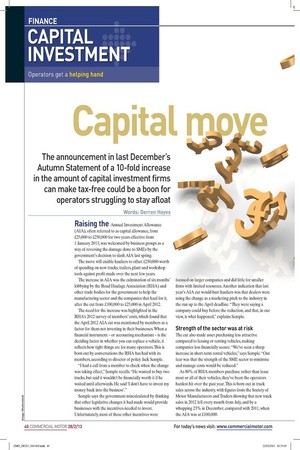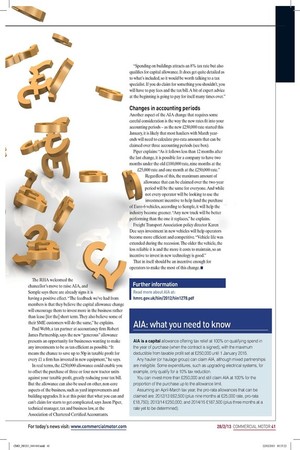Capital icl)
Page 31

Page 32

If you've noticed an error in this article please click here to report it so we can fix it.
The announcement in last December's Autumn Statement of a 10-fold increase in the amount of capital investment firms can make tax-free could be a boon for operators struggling to stay afloat blrui ua. ren Hayes Raising the Annual Investment Allowance (AIA), often referred to as capital allowance, from £25,000 to £250,000 for two years effective from 1 January 2013, was welcomed by business groups as a way of reversing the damage done to SMEs by the government's decision to slash AIA last spring.
The move will enable hauliers to offset £250,000-worth of spending on new trucks, trailers, plant and workshop tools against profit made over the next few years.
The increase in AIA was the culmination of six months' lobbying by the Road Haulage Association (RHA) and other trade bodies for the government to help the manufacturing sector and the companies that haul for it, after the cut from £100,000 to £25,000 in April 2012.
The need for the increase was highlighted in the RHA's 2012 survey of members' costs, which found that the April 2012 AIA cut was mentioned by members as a factor for them not investing in their businesses. When a financial instrument — or accounting mechanism — is the deciding factor in whether you can replace a vehicle, it reflects how tight things are for many operators. This is born out by conversations the RHA has had with its members, according to director of policy Jack Semple.
"I had a call from a member to check when the change was taking effect," Semple recalls. "He wanted to buy two trucks, but said it wouldn't be financially worth it if he waited until afterwards. He said 'I don't have to invest my money back into the business'."
Semple says the government miscalculated by thinking that other legislative changes it had made would provide businesses with the incentives needed to invest. Unfortunately, most of these other incentives were focused on larger companies and did little for smaller firms with limited resources. Another indication that last year's AIA cut would hurt hauliers was that dealers were using the change as a marketing pitch to the industry in the run up to the April deadline. "They were saying a company could buy before the reduction, and that, in our view, is what happened," explains Semple.
Strength of the sector was at risk The cut also made asset purchasing less attractive compared to leasing or renting vehicles, making companies less financially secure. "We've seen a sharp increase in short-term rental vehicles," says Semple. "Our fear was that the strength of the SME sector to minimise and manage costs would be reduced."
As 80% of RHA members purchase rather than lease most or all of their vehicles, they've been the operators hardest hit over the past year. This is born out in truck sales across the industry, with figures from the Society of Motor Manufacturers and Traders showing that new truck sales in 2012 fell every month from July, and by a whopping 23% in December, compared with 2011, when the AIA was at £100,000.
The RHA welcomed the chancellor's move to raise AIA, and Semple says there are already signs it is having a positive effect. "The feedback we've had from members is that they believe the capital allowance change will encourage them to invest more in the business rather than lease [for the] short term. They also believe some of their SME customers will do the same," he explains.
Paul Webb, a tax partner at accountancy firm Robert James Partnership, says the new "generous" allowance presents an opportunity for businesses wanting to make any investments to be as tax-efficient as possible. "It means the chance to save up to 50p in taxable profit for every £1 a firm has invested in new equipment," he says.
In real terms, the £250,000 allowance could enable you to offset the purchase of three or four new tractor units against your taxable profit, greatly reducing your tax bill. But the allowance can also be used on other, non-core aspects of the business, such as yard improvements and building upgrades. It is at this point that what you can and can't claim for starts to get complicated, says Jason Piper, technical manager, tax and business law, at the Association of Chartered Certified Accountants.
"Spending on buildings attracts an 8% tax rate but also qualifies for capital allowance. It does get quite detailed as to what's included, so it would be worth talking to a tax specialist. If you do claim for something you shouldn't, you will have to pay fees and the tax bill. A bit of expert advice at the beginning is going to pay for itself many times over."
Changes in accounting periods Another aspect of the AIA change that requires some careful consideration is the way the new rates fit into your accounting periods — as the new £250,000 rate started this January, it is likely that most hauliers with March yearends will need to calculate pro-rata amounts that can be claimed over three accounting periods (see box).
Piper explains: "As it follows less than 12 months after the last change, it is possible for a company to have two months under the old £100,000 rate, nine months at the £25,000 rate and one month at the £250,000 rate."
isRegardless of this, the maximum amount of - allowance that can be claimed over the two-year period will be the same for everyone. And while not every operator will be looking to use the investment incentive to help fund the purchase of Euro-6 vehicles, according to Semple, it will help the industry become greener. "Any new truck will be better performing than the one it replaces," he explains.
Freight Transport Association policy director Karen Dee says investment in new vehicles will help operators become more efficient and competitive. "Vehicle life was extended during the recession. The older the vehicle, the less reliable it is and the more it costs to maintain, so an incentive to invest in new technology is good."
That in itself should be an incentive enough for operators to make the most of this change. • Further information Read more about AIA at: hmrc.gov.uldtiin/2012/tiin1278.pdf AIA: what you need to know AIA is a capital allowance offering tax relief at 100% on qualifying spend in the year of purchase (when the contract is signed), with the maximum deductible from taxable profit set at £250,000 until 1 January 2015.
Any haulier (or haulage group) can claim AIA, although mixed partnerships are ineligible. Some expenditures, such as upgrading electrical systems, for example, only qualify for a 10% tax reduction.
You can invest more than £250,000 and still claim AIA at 100% for the proportion of the purchase up to the allowance limit.
Assuming an April-March tax year, the pro-rata allowances that can be claimed are: 2012/13 £62,500 (plus nine months at £25,000 rate, pro-rata £18,750); 2013/14 £250,000; and 2014/15 £187,500 (plus three months at a rate yet to be determined).







































